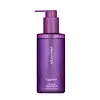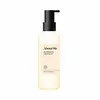What's inside
What's inside
 Key Ingredients
Key Ingredients

 Benefits
Benefits

 Concerns
Concerns

 Ingredients Side-by-side
Ingredients Side-by-side

Ethylhexyl Palmitate
EmollientSorbeth-30 Tetraoleate
EmulsifyingTriethylhexanoin
MaskingCaprylic/Capric Triglyceride
MaskingMacadamia Ternifolia Seed Oil
EmollientPolyisobutene
Tocopherol
AntioxidantCaprylyl Glycol
EmollientEthylhexylglycerin
Skin ConditioningEclipta Prostrata Extract
Skin ConditioningMelia Azadirachta Leaf Extract
Skin ConditioningSimmondsia Chinensis Seed Oil
EmollientAdansonia Digitata Seed Oil
EmollientBorago Officinalis Seed Oil
EmollientMelia Azadirachta Flower Extract
Skin ConditioningWater
Skin ConditioningCoccinia Indica Fruit Extract
Skin ConditioningMoringa Oleifera Seed Oil
EmollientSolanum Melongena Fruit Extract
Skin ConditioningButyl Avocadate
Skin ConditioningButylene Glycol
HumectantPropanediol
SolventCurcuma Longa Root Extract
MaskingCorallina Officinalis Extract
Skin ConditioningOcimum Sanctum Leaf Extract
Skin ConditioningDipropylene Glycol
Humectant1,2-Hexanediol
Skin ConditioningGlycerin
HumectantCastanea Crenata Shell Extract
Skin ConditioningCamellia Sinensis Leaf Extract
AntimicrobialSalix Alba Bark Extract
AstringentSaponaria Officinalis Leaf Extract
AntimicrobialVaccinium Macrocarpon Fruit Extract
AstringentHydroxycinnamic Acid
Skin ConditioningRutin
AntioxidantParfum
MaskingEthylhexyl Palmitate, Sorbeth-30 Tetraoleate, Triethylhexanoin, Caprylic/Capric Triglyceride, Macadamia Ternifolia Seed Oil, Polyisobutene, Tocopherol, Caprylyl Glycol, Ethylhexylglycerin, Eclipta Prostrata Extract, Melia Azadirachta Leaf Extract, Simmondsia Chinensis Seed Oil, Adansonia Digitata Seed Oil, Borago Officinalis Seed Oil, Melia Azadirachta Flower Extract, Water, Coccinia Indica Fruit Extract, Moringa Oleifera Seed Oil, Solanum Melongena Fruit Extract, Butyl Avocadate, Butylene Glycol, Propanediol, Curcuma Longa Root Extract, Corallina Officinalis Extract, Ocimum Sanctum Leaf Extract, Dipropylene Glycol, 1,2-Hexanediol, Glycerin, Castanea Crenata Shell Extract, Camellia Sinensis Leaf Extract, Salix Alba Bark Extract, Saponaria Officinalis Leaf Extract, Vaccinium Macrocarpon Fruit Extract, Hydroxycinnamic Acid, Rutin, Parfum
Ethylhexyl Palmitate
EmollientSorbeth-30 Tetraoleate
EmulsifyingTriethylhexanoin
MaskingCetyl Ethylhexanoate
EmollientDiisostearyl Malate
EmollientCaprylic/Capric Triglyceride
MaskingOryza Sativa Bran Oil
EmollientArtemisia Vulgaris Oil
PerfumingTocopherol
AntioxidantHelianthus Annuus Seed Oil
EmollientWater
Skin ConditioningHippophae Rhamnoides Fruit Oil
Skin ProtectingGalactomyces Ferment Filtrate
HumectantButylene Glycol
HumectantGlycerin
HumectantOryza Sativa Lees Extract
Skin ConditioningPropanediol
Solvent1,2-Hexanediol
Skin ConditioningPentylene Glycol
Skin ConditioningSaccharomyces/Coix Lacryma-Jobi Ma-Yuen Seed Ferment Filtrate
Skin ConditioningSaccharomyces/Barley Seed Ferment Filtrate
HumectantSaccharomyces/Rice Ferment Filtrate
Skin ConditioningCaprylyl Glycol
EmollientLactobacillus/Rice Ferment
Skin ConditioningEthylhexylglycerin
Skin ConditioningOryza Sativa Bran Water
MaskingEthylhexyl Palmitate, Sorbeth-30 Tetraoleate, Triethylhexanoin, Cetyl Ethylhexanoate, Diisostearyl Malate, Caprylic/Capric Triglyceride, Oryza Sativa Bran Oil, Artemisia Vulgaris Oil, Tocopherol, Helianthus Annuus Seed Oil, Water, Hippophae Rhamnoides Fruit Oil, Galactomyces Ferment Filtrate, Butylene Glycol, Glycerin, Oryza Sativa Lees Extract, Propanediol, 1,2-Hexanediol, Pentylene Glycol, Saccharomyces/Coix Lacryma-Jobi Ma-Yuen Seed Ferment Filtrate, Saccharomyces/Barley Seed Ferment Filtrate, Saccharomyces/Rice Ferment Filtrate, Caprylyl Glycol, Lactobacillus/Rice Ferment, Ethylhexylglycerin, Oryza Sativa Bran Water
Ingredients Explained
These ingredients are found in both products.
Ingredients higher up in an ingredient list are typically present in a larger amount.
1,2-Hexanediol is a synthetic liquid and another multi-functional powerhouse.
It is a:
- Humectant, drawing moisture into the skin
- Emollient, helping to soften skin
- Solvent, dispersing and stabilizing formulas
- Preservative booster, enhancing the antimicrobial activity of other preservatives
Butylene Glycol (or BG) is used within cosmetic products for a few different reasons:
Overall, Butylene Glycol is a safe and well-rounded ingredient that works well with other ingredients.
Though this ingredient works well with most skin types, some people with sensitive skin may experience a reaction such as allergic rashes, closed comedones, or itchiness.
Learn more about Butylene GlycolThis ingredient is an emollient, solvent, and texture enhancer. It is considered a skin-softener by helping the skin prevent moisture loss.
It helps thicken a product's formula and makes it easier to spread by dissolving clumping compounds.
Caprylic Triglyceride is made by combining glycerin with coconut oil, forming a clear liquid.
While there is an assumption Caprylic Triglyceride can clog pores due to it being derived from coconut oil, there is no research supporting this.
Learn more about Caprylic/Capric TriglycerideCaprylyl Glycol is a humectant and emollient, meaning it attracts and preserves moisture.
It is a common ingredient in many products, especially those designed to hydrate skin. The primary benefits are retaining moisture, skin softening, and promoting a healthy skin barrier.
Though Caprylyl Glycol is an alcohol derived from fatty acids, it is not the kind that can dry out skin.
This ingredient is also used as a preservative to extend the life of products. It has slight antimicrobial properties.
Learn more about Caprylyl GlycolEthylhexyl Palmitate, also known as octyl palmitate, is created from 2-ethylhexyl alcohol and palmitic acid. It is a fatty acid ester.
The fatty acid content of Ethylhexyl Palmitate makes it an emollient. Emollients help soften and hydrate your skin by trapping moisture within.
Ethylhexyl Palmitate is also used to help improve the texture of cosmetics. It helps other ingredient dissolve in products and help disperse ingredients more evenly.
You'll likely find this ingredient in sunscreen, as it is often used to mix UV-blocking ingredients such as avobenzone and ethylhexyl triazone.
It can also help stabilize the fragrances in a product as a fragrance fixative.
Ethylhexyl Palmitate can be used to substitute mineral oil.
Due to its high fatty acid content, it may not be fungal-acne safe.
Learn more about Ethylhexyl PalmitateEthylhexylglycerin (we can't pronounce this either) is commonly used as a preservative and skin softener. It is derived from glyceryl.
You might see Ethylhexylglycerin often paired with other preservatives such as phenoxyethanol. Ethylhexylglycerin has been found to increase the effectiveness of these other preservatives.
Glycerin is already naturally found in your skin. It helps moisturize and protect your skin.
A study from 2016 found glycerin to be more effective as a humectant than AHAs and hyaluronic acid.
As a humectant, it helps the skin stay hydrated by pulling moisture to your skin. The low molecular weight of glycerin allows it to pull moisture into the deeper layers of your skin.
Hydrated skin improves your skin barrier; Your skin barrier helps protect against irritants and bacteria.
Glycerin has also been found to have antimicrobial and antiviral properties. Due to these properties, glycerin is often used in wound and burn treatments.
In cosmetics, glycerin is usually derived from plants such as soybean or palm. However, it can also be sourced from animals, such as tallow or animal fat.
This ingredient is organic, colorless, odorless, and non-toxic.
Glycerin is the name for this ingredient in American English. British English uses Glycerol/Glycerine.
Learn more about GlycerinPropanediol is an all-star ingredient. It softens, hydrates, and smooths the skin.
It’s often used to:
Propanediol is not likely to cause sensitivity and considered safe to use. It is derived from corn or petroleum with a clear color and no scent.
Learn more about PropanediolSorbeth-30 Tetraoleate is a surfactant and emulsifier.
This ingredient is a tetraester from oleic acid and polyethylene glycol ether of sorbitol.
As an emulsifier, it helps ingredients such as oil and water mix together. This allows the dirt and oils in your skin to be washed away.
One study found pumpkin oil containing Sorbeth-30 Tetraoleate helped hydrate the skin and did not cause any irritation.
Learn more about Sorbeth-30 TetraoleateTocopherol (also known as Vitamin E) is a common antioxidant used to help protect the skin from free-radicals and strengthen the skin barrier. It's also fat soluble - this means our skin is great at absorbing it.
Vitamin E also helps keep your natural skin lipids healthy. Your lipid skin barrier naturally consists of lipids, ceramides, and fatty acids. Vitamin E offers extra protection for your skin’s lipid barrier, keeping your skin healthy and nourished.
Another benefit is a bit of UV protection. Vitamin E helps reduce the damage caused by UVB rays. (It should not replace your sunscreen). Combining it with Vitamin C can decrease sunburned cells and hyperpigmentation after UV exposure.
You might have noticed Vitamin E + C often paired together. This is because it is great at stabilizing Vitamin C. Using the two together helps increase the effectiveness of both ingredients.
There are often claims that Vitamin E can reduce/prevent scarring, but these claims haven't been confirmed by scientific research.
Learn more about TocopherolTriethylhexanoin is created from glycerin and 2-ethylhexanoic acid. It is a solvent and emollient.
As a solvent, Triethylhexanoin helps dissolve ingredients to stable bases or help evenly distribute ingredients throughout the product.
It is also an emollient and helps condition the skin.
Learn more about TriethylhexanoinWater. It's the most common cosmetic ingredient of all. You'll usually see it at the top of ingredient lists, meaning that it makes up the largest part of the product.
So why is it so popular? Water most often acts as a solvent - this means that it helps dissolve other ingredients into the formulation.
You'll also recognize water as that liquid we all need to stay alive. If you see this, drink a glass of water. Stay hydrated!
Learn more about Water